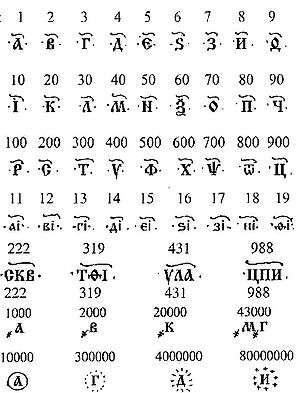Cyrillic numerals
| Numeral systems |
|---|
 |
| Hindu–Arabic numeral system |
| East Asian |
| Alphabetic |
| Former |
| Positional systems by base |
| Non-standard positional numeral systems |
| List of numeral systems |
The Cyrillic numerals are a numeral system derived from the Cyrillic script, developed in the First Bulgarian Empire in the late tenth century. It was used by the First Bulgarian Empire and by South and East Slavic peoples. The system was used in Russia as late as the early 18th century when Peter the Great replaced it with Arabic numerals. The Cyrillic numerals may still be found in books written in the Church Slavonic language.
General description
The system is quasidecimal, basically the Ionian numeral system written with the corresponding graphemes of the Cyrillic script. The order is based on the original Greek alphabet and does not correspond to the different standard Cyrillic alphabetical orders. A separate letter is assigned to each unit (1, 2,... 9), each multiple of ten (10, 20,... 90) and each multiple of one hundred (100, 200,... 900).
The numbers are written as pronounced in Slavonic, generally from high value position to low value position, with the exception of 11 through 19, which are pronounced and written units before tens. For example, 17 is "семнадсять", "s'em'-na-d's'at'" ("seven-on-ten", compare English seven-teen). To cipher a Cyrillic number, one has to add all the figures. To distinguish numbers from text, a titlo ( ҃ ) is drawn over the numbers. If the number exceeds 1000, the thousands sign ( ҂ ) is drawn before the figure, and the thousands figure are written with a letter assigned to the units. To produce larger numbers, a numeral can be enclosed in a modifying sign: a ten-thousands sign ( ⃝ ), a hundred-thousands sign ( ҈ ), a millions sign ( ҉ ), a ten-millions sign ( ꙰ ), a hundred-millions sign ( ꙱ ) or a billions sign ( ꙲ ).


Examples:
-
 – 1706
– 1706 -
 – 7118
– 7118
Glagolitic numerals work similarly except that numeric values are assigned according to the native alphabetic order of the Glagolitic alphabet rather than inherited from the order of the Greek alphabet.
Computing codes
| character | ҃ | ҂ | ⃝ | ҈ | ||||
| Unicode name | COMBINING CYRILLIC TITLO | CYRILLIC THOUSANDS SIGN | COMBINING ENCLOSING CIRCLE (Cyrillic combining ten thousands sign) | COMBINING CYRILLIC HUNDRED THOUSANDS SIGN | ||||
| character encoding | decimal | hex | decimal | hex | decimal | hex | decimal | hex |
| Unicode | 1155 | 0483 | 1154 | 0482 | 8413 | 20DD | 1160 | 0488 |
| UTF-8 | 210 131 | D2 83 | 210 130 | D2 82 | 226 131 157 | E2 83 9D | 210 136 | D2 88 |
| Numeric character reference | ҃ | ҃ | ҂ | ҂ | ⃝ | DD; | ҈ | ҈ |
| character | ҉ | ꙰ | ꙱ | ꙲ | ||||
| Unicode name | COMBINING CYRILLIC MILLIONS SIGN | COMBINING CYRILLIC TEN MILLIONS SIGN | COMBINING CYRILLIC HUNDRED MILLIONS SIGN | COMBINING CYRILLIC THOUSAND MILLIONS SIGN | ||||
| character encoding | decimal | hex | decimal | hex | decimal | hex | decimal | hex |
| Unicode | 1161 | 0489 | 42608 | A670 | 42609 | A671 | 42610 | A672 |
| UTF-8 | 210 137 | D2 89 | 234 153 176 | EA 99 B0 | 234 153 177 | EA 99 B1 | 234 153 178 | EA 99 B2 |
| Numeric character reference | ҉ | ҉ | ꙰ | ꙰ | ꙱ | ꙱ | ꙲ | ꙲ |
See also
| Wikimedia Commons has media related to Cyrillic numerals. |
References
- Гаманович, Алипий (1984) [1964]. Grammar of the Church Slavonic Language. Jordanville, NY: Printshop of St. Job of Pochaev. p. 271. ISBN 9780884650645.